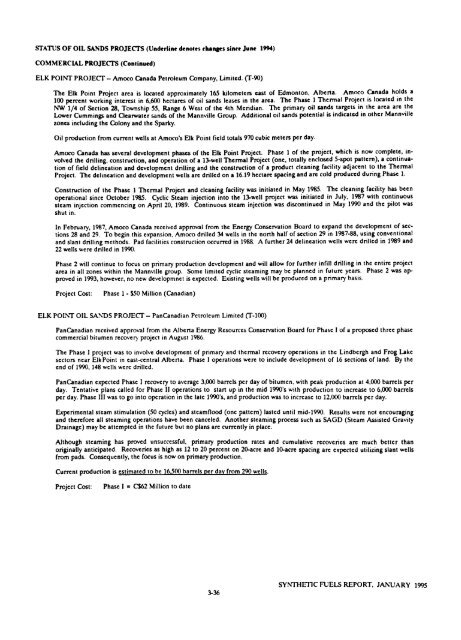Ikelic - Alliance Digital Repository
Ikelic - Alliance Digital Repository
Ikelic - Alliance Digital Repository
You also want an ePaper? Increase the reach of your titles
YUMPU automatically turns print PDFs into web optimized ePapers that Google loves.
STATUS OF OIL SANDS PROJECTS (Underline denotes changes since June 1994)<br />
COMMERCIAL PROJECTS (Continued)<br />
- ELK POINT PROJECT Amoco<br />
Canada Petroleum Company, Limited. (T-90)<br />
The Elk Point Project area is located approximately 165 kilometers east of Edmonton, Alberta. Amoco Canada holds a<br />
100 percent working interest in 6,600 hectares of oil sands leases in the area. The Phase 1 Thermal Project is located in the<br />
NW 1/4 of Section 28, Township 55, Range 6 West of the 4th Meridian. The primary oil sands targets in the area are the<br />
Lower Cummings and Clearwater sands of the Mannville Group. Additional oil sands potential is indicated in other Mannville<br />
zones including the Colony and the Sparky.<br />
Oil production from current wells at Amoco's Elk Point field totals 970 cubic meters per day.<br />
Amoco Canada has several development phases of the Elk Point Project. Phase 1 of the project, which is now complete, in<br />
voked the drilling, construction, and operation of a 13-well Thermal Project (one, totally enclosed 5-spot pattern), a continua<br />
tion of field delineation and development drilling and the construction of a product cleaning facility adjacent to the Thermal<br />
Project. The delineation and development wells are drilled on a 16.19 hectare spacing and are cold produced during Phase 1.<br />
Construction of the Phase 1 Thermal Project and cleaning facility was initiated in May 1985. The cleaning facility<br />
has been<br />
operational since October 1985. Cyclic Steam injection into the 13-well project was initiated in July, 1987 with continuous<br />
steam injection commencing on April 20, 1989. Continuous steam injection was discontinued in May 1990 and the pilot was<br />
shut in.<br />
In February, 1987, Amoco Canada received approval from the Energy Conservation Board to expand the development of sec<br />
tions 28 and 29. To begin this expansion, Amoco drilled 34 wells in the north half of section 29 in 1987-88, using conventional<br />
and slant methods. drilling Pad facilities construction occurred in 1988. A further 24 delineation wells were drilled in 1989 and<br />
22 wells were drilled in 1990.<br />
Phase 2 will continue to focus on primary production development and will allow for further infill drilling in the entire project<br />
area in all zones within the Mannville group. Some limited cyclic steaming may be planned in future years. Phase 2 was ap<br />
proved in 1993, however, no new developmnet is expected. Existing wells will be produced on a primary basis.<br />
Project Cost: Phase 1 $50 Million (Canadian)<br />
- ELK POINT OIL SANDS PROJECT PanCanadian<br />
Petroleum Limited (T-100)<br />
PanCanadian received approval from the Alberta Energy Resources Conservation Board for Phase I of a proposed three phase<br />
commercial bitumen recover) project in August 1986.<br />
The Phase I project was to involve development of primary and thermal recovery operations in the Lindbergh and Frog Lake<br />
sectors near Elk Point in east-central Alberta. Phase I operations were to include development of 16 sections of land. By the<br />
end of 1990, 148 wells were drilled.<br />
PanCanadian expected Phase I recovery to average 3,000 barrels per day of bitumen, with peak production at 4,000 barrels per<br />
day. Tentative plans called for Phase II operations to start up in the mid 1990's with production to increase to 6,000 barrels<br />
per day. Phase III was to go into operation in the late 1990's, and production was to increase to 12.000 barrels per day.<br />
Experimental steam stimulation (50 cycles) and steamflood (one pattern) lasted until mid-1990. Results were not encouraging<br />
and therefore all operations steaming have been canceled. Another steaming process such as SAGD (Steam Assisted Gravity<br />
Drainage) may be attempted in the future but no plans are currently in place.<br />
Although steaming has proved unsuccessful, primary production rates and cumulative recoveries are much better than<br />
originally anticipated. Recoveries as high as 12 to 20 percent on 20-acre and 10-acre spacing are expected utilizing slant wells<br />
from pads. Consequently, the focus is now on primary production.<br />
Current production is estimated to be 16300 barrels per day from 290 wells.<br />
Project Cost: Phase I = C$62 Million to date<br />
3-36<br />
SYNTHETIC FUELS REPORT, JANUARY 1995















![pace SrntfletIc fne]its report - Alliance Digital Repository](https://img.yumpu.com/10493335/1/190x245/pace-srntfletic-fneits-report-alliance-digital-repository.jpg?quality=85)
